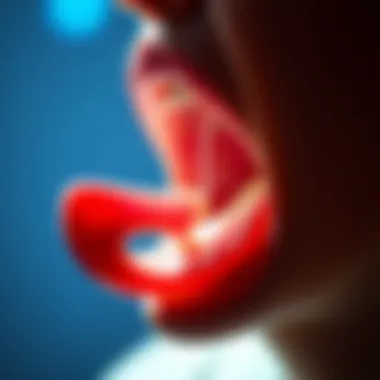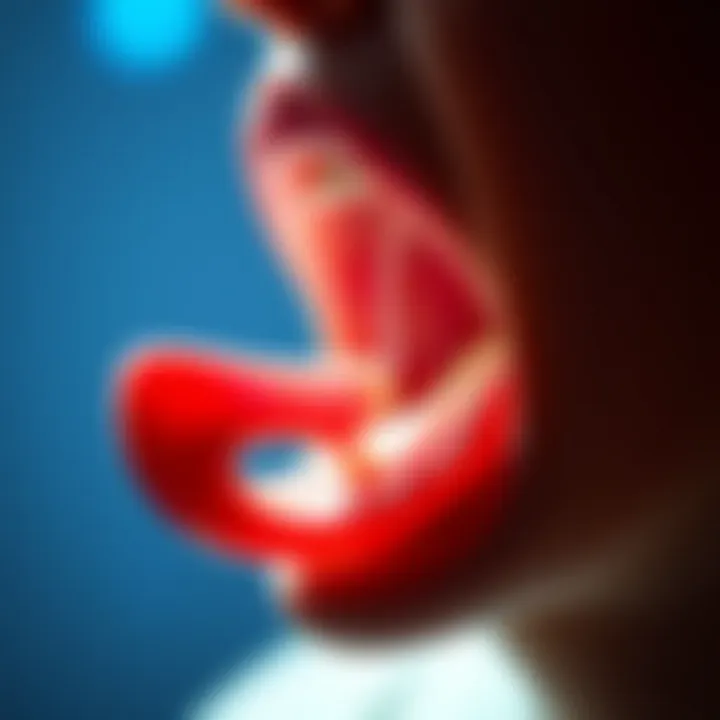Comprehensive Strategies for Dysphagia Treatment


Intro
Dysphagia, the medical term for difficulty swallowing, is a condition that many overlook until confronted with its impact. It may seem mundane, but for those grappling with this challenge, each meal can become a battleground, fraught with anxiety and health risks. This article aims to shed light on how best to manage dysphagia, walking through the landscape of treatment options, from diagnostic techniques to the latest therapeutic advancements.
Understanding the nuances of dysphagia is crucial. It’s not merely a physical impediment; it intertwines with psychological aspects and lifestyle changes that can considerably affect a patient’s quality of life. The road to effective management starts with diagnosis, a vital first step that sets the tone for the entire treatment process. We'll explore how healthcare professionals are equipped to tackle this condition and the innovative tools at their disposal. Additionally, the conversation will address the role of medications and lifestyle adaptations, as these facets often play a significant role in improving swallowing health.
By the end of our exploration, readers should have a robust framework for understanding dysphagia treatment, enriched by insights from current research and clinical practices. Given the complex nature of this condition, the synthesis of information presented here seeks to empower both healthcare providers and patients alike, encouraging a proactive approach to managing dysphagia.
Understanding Dysphagia
Dysphagia is more than just a clinical term; it’s a profound condition that can drastically affect one’s quality of life. This section lays the groundwork for understanding dysphagia, focusing on what it is, the types it encompasses, and the causative factors that lead to this condition. Without that foundational comprehension, attempts to treat or manage dysphagia lack context, and informed care becomes challenging. Individuals grappling with this issue often find that their relationships, careers, and overall well-being suffer. Understanding dysphagia isn’t just about recognizing symptoms; it’s about becoming aware of its broader implications and the paths toward better management.
Definition and Types of Dysphagia
At its core, dysphagia is defined as difficulty in swallowing. But, it isn’t a one-size-fits-all condition. Dysphagia can be classified into two principal types: oropharyngeal dysphagia and esophageal dysphagia. Oropharyngeal dysphagia involves problems in the mouth and throat—typically a motor issue when handling the bolus. It is frequently observed in patients with neurological conditions like stroke. On the other hand, esophageal dysphagia relates to issues further down the digestive tract, often due to obstructions or structural anomalies in the esophagus.
Causes of Dysphagia
Understanding the causes behind dysphagia is crucial for effective treatment. The underlying factors can range from neurological disorders to muscular conditions, structural abnormalities, and various medical conditions. This breadth of causes illustrates the complexity of dysphagia and highlights the need for a tailored approach to each patient’s unique situation.
Neurological Disorders
Neurological disorders can play a significant role in dysphagia. Conditions such as Parkinson’s disease or Amyotrophic Lateral Sclerosis (ALS) affect the brain's communication with the muscles responsible for swallowing. The key characteristic here is the disruption in the motor control and coordination required for swallowing. This makes issues like aspiration and choking much more common among these patients. Understanding neurological contributions to dysphagia offers vital insights into how affected individuals can engage in targeted therapies that focus on regaining control over these vital motor functions.
Muscular Conditions
Muscular conditions, such as myasthenia gravis or muscular dystrophy, can also significantly contribute to dysphagia. In these cases, the muscles that facilitate swallowing may not function correctly, leading to weakness and fatigue. The defining aspect of these conditions is muscle deterioration or dysfunction, making it a relevant discussion for this article. An individual with muscular disorders often experiences a slow progression of symptoms, leading to many choices in management, from dietary changes to specific therapeutic exercises.
Structural Abnormalities
Structural abnormalities refer to physical irregularities within the throat or esophagus, such as strictures or tumors. These obstructions can impede the normal swallowing process, causing discomfort or pain while eating. A critical takeaway here is that these abnormalities can often be identified through imaging studies and may require surgical intervention or medication for resolution. The unique feature of structural issues is their potentially life-threatening nature if left unaddressed. Therefore, understanding how these structures impact swallowing can help target appropriate treatment modalities.
Medical Conditions
Various medical conditions, including cancer, arthritis, or gastroesophageal reflux disease (GERD), can also lead to dysphagia. These diseases often create complications in swallowing due to inflammation, pain, or mechanical disruptions. Characteristically, the complexity arises from the multifactorial nature of these conditions, where dysphagia is just one symptom among many. Understanding how these medical issues contribute to swallowing difficulties is vital for developing comprehensive treatment plans that address the root causes rather than merely alleviating symptoms.
Understanding dysphagia not only aids healthcare providers in diagnosing and treating but empowers patients to engage in their wellness journeys actively.
Symptoms and Diagnosis
Understanding the symptoms and the process of diagnosis for dysphagia is crucial for effective treatment. Symptoms serve as the first indicators that something may be amiss, prompting patients to seek medical attention. Without appropriate diagnosis, dysphagia could lead to severe complications such as aspiration pneumonia or malnutrition. Recognizing the symptoms early can also pave the way for timely and relevant therapeutic interventions, ultimately enhancing the quality of life for affected individuals.
Common Symptoms of Dysphagia
Dysphagia manifests through a variety of symptoms, which may range from mild discomfort to severe difficulty. Some of the common symptoms include:
- Difficulty swallowing: This may present as a sensation of food being stuck in the throat or chest.
- Choking or coughing: Particularly during or immediately after eating or drinking warns of potential issues.
- Pain while swallowing: Sometimes, swallowing can become painful, indicating an underlying problem.
- Regurgitation: This can occur when food comes back up from the stomach, causing distress.
- Weight loss: Infrequently consuming enough food due to dysphagia may lead to noticeable weight loss over time.
- Change in eating habits: Affected individuals might start avoiding certain types of food or may eat more slowly.
Recognizing these symptoms promptly is essential. Upon noticing any significant changes, individuals should consult healthcare providers so an appropriate course of action can be designed.
Diagnostic Procedures
To ascertain the root cause of dysphagia, healthcare professionals often employ a range of diagnostic procedures. These evaluations help pinpoint the underlying issue, enabling targeted treatments. Each procedure has its own strengths and weaknesses, making them integral in managing dysphagia effectively.
Barium Swallow Study
The barium swallow study is a significant diagnostic tool that helps visualize the swallowing process. During this test, a patient consumes a barium solution, which coats the esophagus and stomach, then X-rays are taken to capture the swallowing dynamics. What makes this study beneficial is its ability to assess both structural and functional aspects of swallowing. It's particularly useful for identifying obstructions or abnormalities in the esophagus.
One key characteristic of the barium swallow study is its relatively non-invasive nature, which can be appealing to many patients. However, it does have its downsides; for instance, some may find the barium taste unpleasant. Additionally, the study may not capture subtle neurological issues that might affect swallowing.
Endoscopic Evaluation


Another widely used procedure is endoscopic evaluation, which allows for a direct visualization of the esophagus and throat using a flexible tube with a camera. This method offers significant insights into potential structural abnormalities or lesions that could interfere with swallowing. The advantage of using an endoscopic approach lies in its ability to provide real-time feedback, making it easier for physicians to make immediate assessments.
Despite being a strong diagnostic tool, it does pose certain risks such as discomfort during the procedure or potential complications related to sedation. Yet, the precision it offers often outweighs these concerns, particularly when trying to navigate complex cases of dysphagia.
Manometry
Manometry is a specialized test that measures the pressure and coordination of muscle contractions in the esophagus during swallowing. This diagnostic procedure stands out due to its focus on the functional aspects of the swallowing mechanism. It is beneficial for identifying issues related to muscle dysfunction or nerve damage, both of which can cause dysphagia.
One unique feature of manometry is its capacity to provide detailed information on esophageal motility. However, it might not reveal structural problems, which is where barium swallow studies or endoscopic evaluations come into play. As such, manometry is better utilized as a complement to other diagnostic methods.
In summary, understanding the symptoms of dysphagia and being aware of the diagnostic procedures available is paramount. With a blend of these approaches, healthcare providers can formulate an effective treatment strategy, addressing the diverse and complex nature of dysphagia. For more information on dysphagia and its management, resources are available at brtannica.com, medlineplus.gov, and mayoclinic.org.
Pharmacological Approaches
Pharmacological approaches play a crucial role in managing dysphagia, addressing not only the symptoms but also the underlying causes that may impair swallowing. These medical strategies often complement therapeutic interventions, providing patients with a comprehensive management plan. Pharmacotherapy can significantly improve the quality of life for individuals coping with dysphagia. It's essential to appreciate how specific medications can potentially facilitate safer swallowing and minimize discomfort.
Medications for Dysphagia Management
Proton Pump Inhibitors
Proton pump inhibitors (PPIs) are a class of medications often utilized to manage conditions affecting the esophagus, such as gastroesophageal reflux disease (GERD). This issue can commonly contribute to dysphagia symptoms. The specific aspect of PPIs pertains to their ability to reduce stomach acid production, thereby mitigating irritation of the esophagus. The key characteristic of these drugs is their targeted mechanism—they inhibit the proton pumps responsible for acid secretion in the stomach.
PPIs like omeprazole and lansoprazole are widely known options in this category. Their primary benefit lies in providing relief from symptoms associated with acid reflux, which can improve swallowing quality by relieving discomfort that might hinder the swallowing process. However, they also have potential downsides, such as a risk of long-term use leading to vitamin deficiencies (e.g., B12) and an increased likelihood of gastrointestinal infections. This contrasting unique feature makes their use something to consider with caution, weighing the advantages against possible drawbacks.
Anti-inflammatory Drugs
Anti-inflammatory drugs can also contribute significantly to managing dysphagia by addressing inflammation that affects the swallowing mechanism. Conditions like esophagitis, often due to irritation or infection, can present barriers to swallowing due to the swelling and discomfort they create. These medications can reduce the inflammatory response, thereby allowing for better function and comfort during swallowing.
The key characteristic of anti-inflammatory drugs, such as corticosteroids or non-steroidal anti-inflammatory drugs (NSAIDs), is their efficacy in lowering inflammation. They are particularly useful in acute cases where swelling is significant. One benefit of these medications in this context is their relatively rapid action, helping patients experience relief sooner. However, they also come with their own set of disadvantages, such as possible side effects including gastrointestinal irritation or increased blood pressure. Understanding these nuances is essential for healthcare providers when recommending treatments.
Emerging Pharmacological Treatments
Emerging pharmacological treatments are increasingly gaining attention in dysphagia management. Research is continually uncovering new possibilities that can address the multifaceted nature of swallowing difficulties beyond conventional therapies. For example, drugs aimed at neuromodulation are being studied for their potential effects on muscle tone and contractions in the esophagus.
In this section, novel compounds, new applications of existing medications, and innovative approaches will be highlighted to showcase the future possibilities in dysphagia treatment. As research unveils these new therapeutic agents, understanding their underlying mechanisms will be crucial. Further investigation may lead to more effective treatment regimens tailored to individual patient needs, thus enhancing the overall efficacy of dysphagia management.
Therapeutic Interventions
Dysphagia treatment heavily relies on therapeutic interventions that aim to improve swallowing functionality. These methods offer both immediate assistance and long-term strategies for management, literally reshaping how patients approach eating and drinking. It’s essential to recognize that the path of recovery is not one-size-fits-all; each intervention can be tailored to meet the distinct needs of individuals, making it a core component in a comprehensive dysphagia treatment plan.
Using therapeutic interventions not only aids in easing the physical challenge of swallowing but also brings a sense of normalcy back into the lives of those affected by this condition. The psychological dimension is equally significant as individuals often associate eating with social interactions and comfort. Hence, the right therapeutic measures can contribute positively to both their physical health and emotional well-being.
Swallowing Therapy Techniques
Effective swallowing therapy techniques can significantly enhance patient outcomes. Two principal types—compensatory and rehabilitative therapy—serve different but complementary purposes.
Compensatory Techniques
Compensatory techniques focus on modifying the way patients swallow to reduce the risk of aspiration and facilitate safer eating. Key characteristics of compensatory strategies include adjustments in posture and swallowing patterns to make the act of swallowing less hazardous. This method is particularly beneficial for patients experiencing acute dysphagia or those unable to undertake intensive rehabilitation.
- Unique Feature: One of the standout aspects of compensatory techniques lies in their immediate applicability; patients can often begin using these strategies the same day they are introduced. This makes it a preferred choice in clinical settings where rapid adjustments are necessary.
- Advantages: Not only do these techniques provide an instant solution for patients struggling with swallowing, but they can also serve as crucial interim measures while rehabilitative therapies are initiated. However, it should be noted that these techniques might not be sustainable long-term solutions for all patients, particularly if they rely solely on these methods without pursuing further therapeutic options.
Rehabilitative Therapy
Rehabilitative therapy, on the other hand, revolves around strengthening the muscles involved in swallowing through targeted exercises. This type of therapy focuses on enhancing the overall functionality of the swallow reflex, making it a vital component for long-term management of dysphagia.
- Unique Feature: The emphasis here is on muscle coordination and strength, often requiring a structured program that includes various exercises designed to retrain the swallowing mechanism. This type of therapy can take longer to see significant results but is about building a more sustainable solution.
- Advantages: Rehabilitative therapy has the potential to lead patients toward regaining full swallowing function over time, improving their quality of life. However, it does require consistent participation and, at times, guidance from trained professionals to ensure the exercises are performed correctly and effectively.
Role of Speech-Language Pathologists
Speech-language pathologists play a crucial role in the therapeutic intervention landscape for dysphagia. They are the specialists who evaluate swallowing difficulties and implement tailored treatment plans based on individual assessments.
Their expertise doesn’t just lie in the technical aspects of swallowing;| they also educate patients and their families on how to navigate everyday eating challenges effectively.


Speech-language pathologists are vital in assessing the nuances of dysphagia, ensuring that every intrinsic factor—from physiological to emotional—is considered. This holistic approach means that they do not merely treat the symptoms but also enhance the overall experience of eating and drinking for patients.
"A well-coordinated approach involving speech-language pathologists can significantly enhance the quality of life for individuals living with dysphagia."
In summary, therapeutic interventions such as swallowing therapy and the essential role of professionals like speech-language pathologists underscore the importance of a multifaceted approach to managing dysphagia. The goal remains not only to improve the mechanics of swallowing but also to restore dignity and comfort to the act of eating.
Nutritional Management
When it comes to managing dysphagia, nutritional management stands out as a crucial element. Its significance cannot be overstated; this approach can profoundly enhance the quality of life for individuals struggling with swallowing difficulties. The primary aim of nutritional management is not just to provide sustenance, but to create a safe and enjoyable eating experience, tailored specifically to the needs and limitations of the patient.
In tackling dysphagia with nutritional strategies, the focus leans heavily toward dietary modifications and nutritional supplements. These components are designed not only to ensure adequate calorie intake but also to minimize the risk of aspiration, thereby preventing complications such as pneumonia.
Dietary Modifications
Texture Modifications
One of the foundational aspects of dietary modifications is texture modifications. This technique involves altering the physical form of food to make it safer and easier to swallow for individuals with dysphagia. Foods may be modified to include purees, soft foods, or even thicker items that hold together better when ingested.
The key characteristic of texture modifications is their adaptability. They can be customized based on the individual’s swallowing ability, which can vary widely among patients. A popular choice in dysphagia management, these modifications are fundamentally aimed at reducing the effort needed to swallow. Moreover, they often come with the hospitality of preserving flavors and enjoying a variety of meals, which can be vital for overall well-being.
Despite their advantages, texture modifications do present certain obstacles. Some individuals may find it emotionally distressing to reconcile with the necessity of altering their food preferences or even face aversion to new textures that may not be palatable for them. However, the balance they provide between safety and nourishment can outweigh these drawbacks.
Liquid Consistency Adjustments
Following closely is the approach of liquid consistency adjustments. It targets the viscosity of liquids to accommodate various swallowing dysfunctions. The thickness of liquids can significantly influence the ease of swallowing, with options ranging from thin liquids to nectar-thick and pudding-thick. Each category is chosen based on evaluations during swallowing assessments.
The main feature of liquid consistency adjustments makes them particularly beneficial is the wide range of choices available. Affected individuals can have their drinks thickened according to their comfort level, reducing the chance of aspiration. This not only aids in safe swallowing but can also enhance enjoyment as well as hydration, which is often overlooked.
Nevertheless, just like with texture modifications, adjusting liquid consistency has its own challenges. Some patients may find thickened liquids unappealing, impacting their overall fluid intake, which could pose a risk of dehydration. Balancing texture and taste while accommodating safety is essential in the success of this method.
Nutritional Supplements
Nutritional supplements also play a vital role in managing dysphagia. These products can provide necessary nutrients that individuals may lack due to their modified diets. Such supplements often come in the form of powders or ready-to-drink options that are easy to consume.
Using nutritional supplements can enhance the caloric intake without requiring the patient to consume large quantities of food. This is especially advantageous for those who might experience fatigue during meals or simply find the act of eating challenging. Additionally, certain supplements are explicitly formulated to contain vital vitamins and minerals, making sure patients receive comprehensive nutrition while dealing with the restrictions imposed by dysphagia.
In sum, effective nutritional management is multi-faceted, focusing on the interaction between dietary modifications and nutritional supplementation. Striking a balance that prioritizes both safety and enjoyment requires careful consideration and should be guided by healthcare professionals skilled in dysphagia management. While challenges exist, the benefits of tailored nutritional approaches are worth the effort, emphasizing not just feeding the body, but enhancing the life quality of individuals with dysphagia.
Lifestyle and Home Remedies
When dealing with dysphagia, integrating specific lifestyle changes and home remedies can make a significant difference. These approaches are not merely add-ons; they form a critical pillar in the management strategy for individuals grappling with swallowing difficulties. The goal is to enhance comfort, improve swallowing efficiency, and boost overall quality of life.
Adopting lifestyle modifications can empower patients and their families, fostering a sense of control and adaptability in navigating this challenging condition.
Positioning Techniques
Positioning during meals plays an indispensable role in managing dysphagia. Proper alignment can have a profound impact on the ease of swallowing. For instance, sitting upright is often recommended, as it might aid gravity in directing the food down the esophagus more smoothly. A slightly forward-leaning position can encourage better transit of food, reducing the chance of aspiration.
It's noted that certain techniques, such as the chin-tuck maneuver, may further assist in swallowing. By lowering the chin toward the chest while swallowing, a patient may find that it enhances the airway protective reflexes, potentially decreasing the risk of choking. However, every individual is unique, and positioning should be tailored based on personal comfort and clinical guidance.
Hydration and Diet Practices
Staying adequately hydrated is crucial for anyone with dysphagia. Dehydration can further complicate swallowing issues and lead to additional health concerns. Having a schedule for fluid intake can encourage patients to drink more regularly than they might otherwise. However, not all liquids are equal. Some may need to adjust the consistency of liquids to make swallowing easier. Thickening agents, for example, can help turn thin liquids into nectar- or honey-like consistencies, which many find easier to handle.
Dietary practices should not be overlooked either; modifications in food texture can significantly enhance safety and enjoyment while eating. This might involve breaking down food into smaller, softer pieces or opting for pureed foods that are easier to swallow.
Patient and caregiver education is key here. Understanding which foods are suitable and which might pose a risk is essential for informed decision-making. Moreover, social settings such as mealtimes can often become sources of stress for individuals facing dysphagia. Therefore, creating a relaxed and supportive environment can have positive effects on the overall eating experience.
"The most important thing is to pay attention to the needs of the individual. Swallowing difficulties can greatly affect personal dignity, and solutions should aim to enhance rather than limit one's experience."
Implementing these lifestyle recommendations can serve as effective adjuncts to medical treatment, allowing individuals to manage their condition proactively and enjoy a greater sense of well-being. As always, it is wise to consult healthcare providers when making significant changes—what works for one person may not work for another.
Assistive Devices


Assistive devices stand as a significant component in managing dysphagia and the challenges that come with it. For individuals grappling with swallowing difficulties, these tools can provide a vital lifeline. They are not merely adjuncts but rather essential instruments that foster independence, enhance safety during mealtimes, and improve overall quality of life. Equipments tailored for dysphagia can help to mitigate the physical and emotional hurdles faced by patients, bridging the gap between their needs and everyday functionalities.
Modified Cups and Utensils
Modified cups and utensils are specifically designed to accommodate the unique requirements of individuals experiencing dysphagia. These adaptations can range from specialized cups with spouts or straws that control liquid flow to utensils crafted to support a more manageable grip for those with reduced dexterity. The designs often aim to allow a more comfortable and controlled way of consuming food and liquids.
For instance, consider adaptive spoons that feature angled shapes. They assist in delivering food straight from the bowl to the mouth without requiring complicated wrist movements. And when it comes to cups, modified versions can prevent spilling while ensuring that the right amount of liquid enters the mouth at a steady pace. Such devices play a critical role not just in physical facilitation but also in restoring a sense of dignity during meals, as individuals can partake without excessive assistance.
Some key benefits of modified cups and utensils include:
- Enhanced Safety: Reducing the risk of aspiration or choking during meals.
- Promoting Independence: Allowing individuals to feed themselves, enhancing their autonomy at mealtimes.
- Improved Comfort: Making the eating experience less stressful and more enjoyable.
Feeding Devices
Feeding devices encompass a variety of tools designed to assist patients who find meal consumption challenging due to dysphagia. These may include high-tech options such as electronic feeding systems or simpler tools like adaptive plates and bowls that stay grounded and don’t easily tip over. The fundamental characteristic of these feeding devices is their ability to simplify the eating process, making it easier for individuals to enjoy their meals without constant oversight.
One commonly employed device is a weighted spoon, which helps to stabilize hand movements for those who might experience tremors or other involuntary motions. Another useful tool is the universal cuff; it attaches to a utensil and can be fastened to the user’s hand, allowing them to maintain a grip despite strength deficits. Through these innovations, individuals with dysphagia can reclaim pleasurable aspects of eating in a supportive manner.
In summary, assistive devices play an irreplaceable role in the life of someone dealing with dysphagia. As technology and design continue to evolve, these tools will likely become even more effective in delivering support, dignity, and comfort to users. The integration of these devices is not just about functional improvements but also about promoting an overall positive lifestyle for those affected by swallowing disorders, aiding them in navigating the daily realities they face with resilience.
Psychosocial Considerations
Understanding the psychosocial aspects of dysphagia is crucial for adequately addressing the needs of individuals impacted by this condition. Dysphagia isn't just a physical issue; it carries significant emotional weight that can affect a person's overall well-being and quality of life. As professionals in the field, we must pay attention to the nuances that shape patients' experiences and responses to this challenging condition. The importance of recognizing these factors goes beyond merely providing medical treatments—it's about fostering a holistic approach that prioritizes emotional and social health.
Emotional Impact of Dysphagia
Dysphagia can lead to a variety of emotional challenges. For many, the inability to swallow comfortably can invoke feelings of embarrassment, frustration, and isolation. Imagine being at a gathering, food all around, yet feeling that every bite is a battle. This kind of experience can provoke anxiety and lead to social withdrawal.
Moreover, the embarrassment tied to potential choking or other swallowing difficulties can elevate stress levels, making it even harder for patients to enjoy meals. The fear of eating—known as food aversion—can arise, resulting in inadequate nutrition and further exacerbate the health issues.
At times, patients may also experience feelings of helplessness or sadness due to dietary restrictions, which can create an identity shift. Since food is often a central part of socialization, losing that ability can disengage individuals from loved ones. In the words of an insightful patient:
"It’s not just about eating; it’s about sharing moments. When I can’t, I feel like I'm missing out on life."
Support Systems for Patients
Addressing the psychosocial implications of dysphagia often requires a robust support system. This system should include family, healthcare providers, and community resources to facilitate understanding and coping strategies.
Here are some effective support mechanisms:
- Family Involvement: Ensuring that family members are educated about the condition can reduce misconceptions and foster a supportive environment. Communication within families can be a healing factor.
- Support Groups: Joining support groups, either online or in person, can help patients share experiences and strategies to cope. These connections can build a sense of community that lessens feelings of isolation.
- Mental Health Counseling: Sometimes, the emotional toll of dysphagia may require professional help. Counseling can provide coping techniques and help patients process their feelings in a safe space.
- Nutritional Advice: Having access to dietitians who specialize in dysphagia can make a monumental difference. They can create meal plans that are not only safe but also enjoyable, which can boost morale.
In essence, fostering a supportive network is paramount. Understanding dysphagia's emotional landscape is just as important as the physical treatments; indeed, they work hand-in-hand to provide a comprehensive approach to managing this condition.
Future Directions in Dysphagia Research
The exploration of dysphagia treatment is entering a pivotal era, with ongoing research shedding light on innovative methods to enhance patient care. Understanding the future directions in dysphagia research is vital, as it not only drives advancements in medical practices but also fosters insight into potential therapies that could improve the quality of life for those affected by this condition. Addressing dysphagia effectively requires a multifaceted approach that considers both the physiological and psychosocial aspects of swallowing disorders.
In recent years, the emphasis on patient-centered care has become increasingly prominent. By tailoring treatment options to meet individual needs, healthcare providers can optimize management strategies and improve outcomes. New methodologies can bridge the gap between traditional medical practices and modern technologies, paving the way for breakthroughs in dysphagia therapy.
Future research must strive to combine holistic perspectives with advanced scientific techniques, offering a more comprehensive understanding of dysphagia's complexities.
Innovative Research Approaches
Innovative research in dysphagia encompasses a variety of directions. Key areas of focus include:
- Bioengineering: The development of bioengineered tissues or structures that facilitate swallowing may open new avenues for treatment. Research is exploring how these constructs could mimic normal tissue to enhance swallowing efficacy.
- Artificial Intelligence: Utilizing AI tools to analyze swallowing patterns dynamically allows for personalized therapy adjustments. Machine learning algorithms can identify subtle changes in swallowing function that human assessors might miss.
- Telehealth Technologies: With the rise of telemedicine, research into remote swallowing assessments is gaining traction. These technologies allow for more frequent monitoring and immediate feedback, leading to quicker adjustments in care plans.
These innovative approaches are paving the way for comprehensive solutions. The integration of technology with therapy enhances both accessibility and effectiveness of treatment, making it easier for patients to receive personalized care in real time.
Potential Breakthrough Treatments
As research progresses, several potential treatments are emerging with promise for the future of dysphagia management. These include:
- Genetic Therapies: Understanding the genetic underpinnings of some swallowing disorders could lead to targeted therapy. By correcting dysfunction at the cellular or molecular level, researchers hope to rectify the root causes of dysphagia.
- Neuromodulation Techniques: Investigations into electrical or chemical stimulation of the nervous system may restore normal swallowing function in patients with neurological impairments. Techniques involving pudendal nerve stimulation or other strategies are currently being explored in clinical settings.
- Enhanced Rehabilitation Programs: Tailoring rehabilitation programs that combine traditional therapy with technology-based interventions is vital. New approaches could focus on intensive, repetitive swallowing exercises facilitated by virtual reality applications.
The convergence of traditional medicinal practices with recent technological advancements opens doors to more effective treatment options. As healthcare professionals and researchers work collaboratively, the goal remains clear: to improve swallowing health and ultimately enhance the patients' quality of life.
For those keen on following the ongoing developments in this field, resources such as National Institute on Deafness and Other Communication Disorders and American Speech-Language-Hearing Association offer updates and insights into the latest dysphagia research and practices.



